List of medieval great powers
This survey article deals with the world most powerful nations and empires before the Congress of Vienna was held in Vienna, Austria (late 1814), a date used by historians as an epochal event.
A Great power or Nation or Empire is a nation or state that, through its great economic, political and military strength, is able to exert power and influence over not only its own region of the world, but far beyond to others. The term "Great Power" was coined in the diplomatic discourse of the Congress and later used extensively in academic discourse and eventually by the press about the preceding eras, and refers explicitly to international powers after the Congress of Vienna (late September, 1814, to June 9, 1815). It is the object of this article to extend the concept of great power status to the eras before the Congress in order to provide coverage of the whole of human history in the same terms.
- Significance of the Congress
In history and the social sciences, in general, the Congress of Vienna was not just the diplomatic aftermath of the Napoleonic Wars— which in their decades had upset the nature of Europe, confused the "natural order", changed ownership or control of divers things, places and populations— but also a landmark event on its own merits— during which, the shape of modern Europe, and by extension as later events show, the ripples of that emergence came to span the globe in a new phase of Colonial and Merchantile hegemony in what might be termed, the second era of Western Imperialism. In short, as an epoch, the Congress has few peers for the modern world came into being—simply because it and the war, along with the technological advances which accompanied them affected in time every nation and place on the globe and birthed the world of the twentieth century with its world spanning (hot and cold) wars which prefaced the current historic era.
For some parts of the globe, it was but the first era experienced, but the distinction is in the rise of the nation-state founded solidly on nationalism possessing both the will and the means to exercise power (not infrequently by use of military force) vice that of the earlier merchantilistic hegemonies which only occasionally gathered the interest or ire of the ruling monarch.
Ancient Powers
Ancient Near East

The terms ancient Near East or ancient Orient encompass the early civilizations predating classical antiquity in the region roughly corresponding to that described by the modern term Middle East, during the time roughly spanning the Bronze Age from the rise of Sumer and Gerzeh in the 4th millennium BCE to the expansion of the Persian Empire in the 6th century BCE.
The ancient Near East is generally understood as encompassing Mesopotamia (modern Iraq and Syria), Persia (Iran), Armenia, Egypt, the Levant (Israel, Jordan, Lebanon, Syria, Palestinian Authority), and Anatolia (Turkey).
Sumer and Akkad

Sumer (or Šumer) was one of the early civilizations of the Ancient Near East, located in the southern part of Mesopotamia (southeastern Iraq) from the time of the earliest records in the mid 4th millennium BC until the rise of Babylonia in the late 3rd millennium BC. The term "Sumerian" applies to all speakers of the Sumerian language. Sumer together with Ancient Egypt and the Indus Valley Civilization is considered the first settled society in the world to have manifested all the features needed to qualify fully as a "civilization".
Ancient Egypt
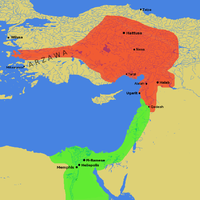
Ancient Egypt was one of the world's first civilizations, with its beginnings in the fertile Nile valley around 3000BC. Ancient Egypt reached the zenith of its power during the New Kingdom (1570–1070 BC) under great pharaohs such as Thutmose III and Ramesses II. It expanded far south into Nubia and held wide territories in the Near East. Ancient Egypt was an example of a nation that used mainly soft power to become a major power. It was one of the first nations to have a system of writing and large scale construction projects. However, as neighboring civilizations developed militaries capable of crossing Egypt's natural barriers, the Egyptian armies were not always able to repel them and so by 1000 BC Egyptian influence as an independent civilization waned.[1]
Elam
Elam is one of the oldest recorded civilizations. Its culture played a crucial role in the Persian Empire, especially during the Achaemenid dynasty that succeeded it, when the Elamite language remained in official use. As such, the Elamite period is considered a starting point for the history of Iran.
Elamite strength was based on an ability to hold various areas together under a coordinated government that permitted the maximum interchange of the natural resources unique to each region. Traditionally, this was done through a federated governmental structure.
The Hurrian kingdoms
The Hurrians refer to a people who inhabited northern Mesopotamia beginning approximately 2500 BC. The Hurrian peoples were not incredibly united, existing as quasi-feudal kingdoms, the most prominent being the Mitanni kingdom, which was at its height towards the close of the 14th century BC. By the 13th century BC, the Hurrian kingdoms had been conquered by foreign powers, chiefly the Assyrians.
Assyria

In the earliest historical times, the term Assyria referred to a region on the Upper Tigris river, named for its original capital, the ancient city of Assur. Later, as a nation and empire that came to control all of the Fertile Crescent, Egypt and much of Anatolia, the term "Assyria proper" referred to roughly the northern half of Mesopotamia (the southern half being Babylonia), with Nineveh as its capital.
The Assyrian homeland was located near a mountainous region, extending along the Tigris as far as the high Gordiaean or Carduchian mountain range of Armenia, sometimes known as the "Mountains of Ashur".
The Assyrian kings controlled a large kingdom at three different times in history. These are called the Old, Middle, and Neo-Assyrian kingdoms, or periods. The most powerful and best-known nation of these periods is the Neo-Assyrian kingdom, 911-612 BC.

Hittite Empire
The Hittites were an ancient people who spoke an Indo-European language, and established a kingdom centered at Hattusa (Hittite URUḪattuša) in north-central Anatolia from the 18th century BC. In the 14th century BC, the Hittite empire was at its height, encompassing central Anatolia, north-western Syria as far as Ugarit, and upper Mesopotamia. After 1180 BC, the empire disintegrated into several independent "Neo-Hittite" city-states, some surviving until as late as the 8th century BC.
The Hittites were also famous for their skill in building and using chariots. The Hittites were pioneers of the Iron Age, manufacturing iron artifacts from as early as the 14th century BC, making them possibly even the first to do so. The Hittites passed much knowledge and lore from the Ancient Near East to the newly arrived Greeks in Europe.
Persian Empire
Achaemenid Empire

The Achaemenid Empire (559 BC–330 BC) was the first of the Persian Empires to rule over significant portions of Greater Iran. At the height of its power, the Empire spanned over three continents. It also eventually incorporated the following territories: in the east modern Afghanistan and beyond into central Asia, and parts of Pakistan; in the north and west all of Asia Minor (modern Turkey), the upper Balkans peninsula (Thrace), and most of the Black Sea coastal regions; in the west and southwest the territories of modern Iraq, northern Saudi-Arabia, Jordan, Israel, Lebanon, Syria, all significant population centers of ancient Egypt and as far west as portions of Libya. Encompassing approximately 7.5 million square kilometers, the Achaemenid Empire was territorially the largest empire of antiquity. In its time it had political power over neighboring countries, and had high cultural and economic achievements during its lengthy rule over a vast region from its picturesque capital at Persepolis.
Sassanid Empire

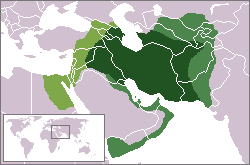
The Sassanid Empire is the name used for the fourth Iranian dynasty, and the second Persian Empire (226 - 651). The empire's territory encompassed all of today's Iran, Iraq, Armenia, Afghanistan, eastern parts of Turkey, and parts of Syria, Pakistan, Caucasia, Central Asia and Arabia. During Khosrau II's rule in 590–628 Egypt, Jordan, Palestine, Lebanon were also briefly annexed to the Empire. The Sassanid era, encompassing the length of the Late Antiquity period, is considered to be one of the most important and influential historical periods in Iran. In many ways the Sassanid period witnessed the highest achievement of Persian civilization, and constituted the last great Iranian Empire before the Muslim conquest and adoption of Islam.
Greek powers
Athens
The History of Ancient Athens is one of the longest of any city in Europe and in the world. Athens has been continuously inhabited for at least 3,000 years. It became the leading city of Ancient Greece in the first millennium BC. Its cultural achievements during the 5th century BC laid the foundations of western civilization. During the Middle Ages, Athens experienced decline and then a recovery under the Byzantine Empire. Athens was relatively prosperous during the Crusades, benefiting from Italian trade.
The 5th century BC marked the zenith of Athens as a center of literature, philosophy (see Greek philosophy) and the arts (see Greek theatre). Some of the most important figures of Western cultural and intellectual history lived in Athens during this period: the dramatists Aeschylus, Aristophanes, Euripides and Sophocles, the philosophers Aristotle, Plato and Socrates,
Sparta

In antiquity Sparta was a Dorian Greek military state, originally centered in Laconia. As a city-state devoted to military training, Sparta possessed the most formidable army in the Greek world, and after achieving notable victories over the Athenian and Persian Empires, regarded itself as the natural protector of Greece.[2] Laconia or Lacedaemon (Λακεδαίμων) was the name of the wider city-state centered at the city of Sparta, though the name "Sparta" is now used for both.
Following the victories in the Messenian Wars (631 BC), Sparta's reputation as a land-fighting force was unequaled.[3] In 480 BC a small Spartan unit under King Leonidas made a legendary last stand against a massive, invading Persian army at the Battle of Thermopylae. One year later, Sparta assembled at full strength and lead a Greek alliance against the Persians at Plataea. There, a decisive Greek victory put an end to the Greco-Persian War along with Persian ambition of expanding into Europe. Even though this war was won by a pan-Greek army, credit was given to Sparta, who besides being the protagonist at Thermopylae and Plataea, had been the nominal leader of the entire Greek expedition.[4]
In later Classical times, Sparta along with Athens, Thebes and Persia had been the main regional powers fighting for supremacy against each other. As a result of the Peloponnesian War, Sparta, a traditionally continental culture, became a naval power. At the peak of her power she subdued many of the key Greek states and even managed to overpower the powerful Athenian navy. By the end of the 5th century she stood out as a state which had defeated at war both the Persian and Athenian Empires, a period which marks the Spartan Hegemony. Sparta was, above all, a militarist state, and emphasis on military fitness began virtually at birth.
Macedonian Empire

Macedon or Macedonia (from Greek Μακεδονία Makedonía; see also List of traditional Greek place names) was the name of an ancient kingdom in the northern-most part of ancient Greece, bordering the kingdom of Epirus on the west and the region of Thrace to the east.[5] For a brief period it became the most powerful state in the ancient Near East after Alexander the Great conquered most of the known world, inaugurating the Hellenistic period of Greek history.
Carthage
Carthage was a major power over the Western Mediterranean between 575 BC and 272 BC.[citation needed] Carthage as a major power was originally a Phoenician settlement, and when Tyre fell to the Assyrians Carthage assumed power over the former settlements of the region. The foundation of Carthaginian power was seafaring trade throughout the Western Mediterranean (following the tracks of the Phoenicians). Although Rome was originally a land based military power, eventually it saw Carthage an enemy and built a navy to challenge them, which led to the three Punic Wars between these powers. The last of these eliminated Carthage as an independent civilization, and left Rome as the most impressive power in the Western Mediterranean.
Hellenistic Kingdoms
Seleucid Empire
Ptolemaic Egypt

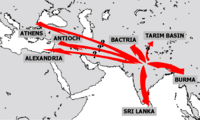
South Asian powers
For most of its history, South Asia (Indian subcontinent) was divided into numerous states. Very few South Asian powers dominated most of the region. However, several South Asian empires were able to expand across Southern Asia, and sometimes into parts of the Middle East, Central Asia and Southeast Asia.
Maurya Empire
The Mauryan Empire was the first political entity to unite most of the Indian subcontinent and expand into Central Asia and the Middle East. Its soft power further spread into much of Persia and Greece due to its military victories over these regions. Its cultural influence also extended into Egypt and Syria. The Empire was founded in 322 BC by Chandragupta Maurya. Chandragupta waged a war against the nearby Greek powers and won, forcing the Greeks to surrender large amounts of land. Under the reign of Ashoka the Great, the empire became pacifist and turned to spreading its soft power in the form of Buddhism.[6]
Gupta Empire
China
-
Qin Dynasty
The Qin Dynasty was preceded by the feudal Zhou Dynasty and followed by the Han Dynasty in China. The unification of China in 221 BCE under the First Emperor Qin Shi Huang marked the beginning of Imperial China, a period which lasted until the fall of the Qing Dynasty in 1912. The Qin Dynasty left a legacy of a centralized and bureaucratic state that would be carried onto successive dynasties.
Han Dynasty
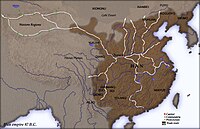
The Han Dynasty (206 BC – AD 220), lasting 400 years, is commonly considered within China to be one of the greatest periods in the entire history of China. At its height, the Han empire extended over a vast territory of 6 million km² and housed a population of approximately 55 million. During this time period, China became a military, economic, and cultural powerhouse. The empire extended its political and cultural influence over Korea, Japan, Mongolia, Vietnam, and Central Asia before it finally collapsed under a combination of domestic and external pressures. The Han Dynasty was arguably the strongest empire in the world during the reign of Emperor Wu, though was established as the largest.
Roman Empire

The Roman Empire is widely known as Europe's largest and most powerful civilization. After the Punic Wars Rome was already the biggest empire on the planet but its expansion continued with the invasions of Greece and Asia Minor. By 27 BC Rome had control over half of Europe as well as Northern Africa and large amounts of the Middle East. The Roman Empire, together with the Han Dynasty of China were the two major empires at this time. Rome also had a developed culture, building on the earlier Greek culture.
From the time of Augustus to the Fall of the Western Empire, Rome dominated Western Eurasia, comprising the majority of its population. Roman expansion began long before the state was changed into an Empire and reached its zenith under emperor Trajan with the conquest of Dacia in AD 106. At this territorial peak, the Roman Empire controlled approximately 5,900,000km²(2,300,000 sq.mi.) of land surface. Rome's influence upon the culture, law, technology, arts, language, religion, government, military, and architecture of Western civilization continues to this day.
Medieval Powers
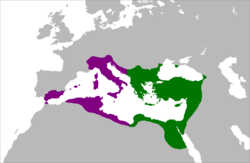
Byzantine Empire (330 - 1453)
The Byzantine Empire is the modern name for the medieval eastern Roman Empire, which survived another 1000 years after the fall of the western Roman Empire, and even managed to reconquer great parts of it. Ancient Roman cultural heritage survived there and gave birth to the Italian Renaissance after its capital, Constantinople, was captured by the Turks in the fifteenth century. The Byzantines were the only Europeans to produce fine silk which was an important source of their wealth along with trade. Byzantium was a major military power with a huge army and strong fleet, and was a major cultural and religious center. It was the stronghold of Eastern Orthodox Christianity and thus influenced many states. It fought against the Arabs to the south, the Bulgarians to the north and the Crusaders, who managed to seize Constantinople in 1204. The Byzantines restored their state in 1261, but its strength never recovered and it was eventually destroyed and replaced by the nascent Ottoman Empire in 1453.
Arab Empire (632 - 1258)
In 622, a new world religion emerged, Islam, founded by Muhammad in Arabia. After his death, his successors began a century of rapid Arab expansion across most of the known world, establishing the Arab Empire as the largest empire the world had yet seen.[citation needed]

Rashidun Caliphate
Under the Rashidun Caliphate, the Muslim Arabs defeated the powerful Sassanid Persian Empire during the Islamic conquest of Persia and the Byzantine Empire during the Byzantine-Arab Wars. The Arabs eventually conquered the Persian Empire and Roman Syria under the famous general Khalid ibn al-Walid, as well as Roman Egypt and Central Asia, all within a decade.
Umayyad Caliphate
The Umayyad Caliphate completed the Muslim expansion after conquering Roman North Africa, Visigothic Hispania, Southern Italy, and parts of the northwestern Indian subcontinent and northwestern China. As a result, the Arab Empire became the largest empire the world had yet seen. However, Umayyad expeditions into the Frankish Kingdom and Byzantium were unsuccessful, as they were eventually stopped by the Bulgarians and Byzantines in 718 and the Franks in 732. Nonetheless, the Caliphate remained a huge military power with mighty navy.
Al-Andalus

Al-Andalus (Arabic: الأندلس) was the Arabic name given to those parts of the Iberian Peninsula governed by Muslims, or Moors, at various times in the period between 711 and 1492.[7] As a political domain or domains, it was successively a province of the Umayyad Caliphate initiated successfully by the Caliph Al-Walid I (711-750), the Emirate of Córdoba (c. 750-929), the Caliphate of Córdoba (929-1031), and finally the Caliphate of Córdoba's taifa (successor) kingdoms.
Abbasid Caliphate
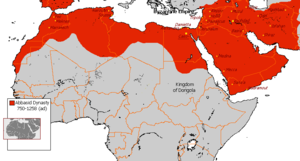
The period of the Abbasid Caliphate is considered the Golden Age of Islam. The empire was rich with flourishing trade across Asia, Europe and Africa. Its culture was thriving, influenced by the Persians, and boasted great achievements in its economy, arts, architecture, literature, mathematics, philosophy, science, and technology. Many cities grew with large populations, beautiful palaces and gardens such as Baghdad, which had a population of a million at its peak, as well as Damascus, Cairo and Cordoba. The Caliphate eventually diminished in size, and was further reduced during the Crusades. The Caliphate later disintegrated after invasions from the Mongol Empire from the east, ending with the sack of Baghdad in 1258.
Fatimid

The Fatimids, Fatimid Caliphate or al-Fātimiyyūn (Arabic الفاطميون) is the Arab Shi'a dynasty that ruled over varying areas of the Maghreb, Egypt, and the Levant from 5 January 909 to 1171, and established the Egyptian city of Cairo as their capital.
Bulgaria (880s - 930s)
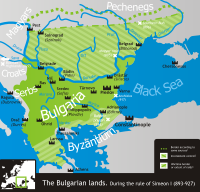
In 681 the Bulgarians established a powerful state which played a major military and cultural role in Medieval Europe [3]. Bulgaria decisively defeated the Arabs in the battle before Constantinople (718) and stopped the Arab invasion in the eastern parts of the continent [4] effectively stopping the migrations of the barbarian tribes (Pechenegs, Magyars, Khazars) further to the west. It destroyed the Avars Khanate in 806. With the adoption of Christianity and the invention of the Cyrillic Alphabet, the Bulgarian Empire became the cultural and spiritual centre of the whole Slavic world. The Bulgarian Orthodox Church became the first National Church in Europe to gain its independence in 927 with its own Patriarch. The Bulgarian Empire reached its biggest size in the early 900s stretching from the Black Sea to Bosnia. [5]
Ghaznavid Empire (960s - 998)
Kingdom of Hungary (1300s - 1380s)
Frankish Empire (790s - 840s)
The Franks were united for the first time by Clovis I in the late 5th century. In 732 they managed to defeat the Arabs at Poitiers, thereby halting their invasion of Western Europe. During the reign of Charlemagne, it reached its greatest extent, encompassing most of the territory of the Western Roman Empire, and eventually he was proclaimed Emperor by the Pope in 800. He Christianised the pagan peoples he defeated. This was a period of cultural revival known as the Carolingian Renaissance with important educational and writing reforms. The empire disintegrated into three parts after the death of his son Louis the Pious, from which later emerged France and Germany.
Holy Roman Empire (840s - 1510s)

The Holy Roman Empire was a mainly Germanic conglomeration of lands in Central Europe during the Middle Ages and the early modern period. It was also known as the Holy Roman Empire of the German Nation from the late 15th century onwards. For centuries historians have treated the Holy Roman Empire as completely distinct from the Roman Empire of classical times.
At its post-Carolingian peak, the Holy Roman Empire encompassed the territories of present-day Austria, Germany, Switzerland, Liechtenstein, Luxembourg, Czech Republic, Slovenia, Belgium, and the Netherlands as well as large parts of modern Poland, France and Italy.
Angevin Empire (1154-1453)
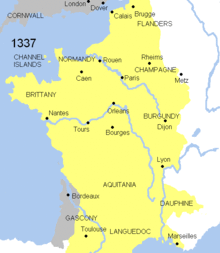
The Angevin Empire was a collection of states ruled by the Plantagenet dynasty. The Plantagenets ruled over the Kingdom of England, the Duchy of Normandy, the Duchy of Aquitaine, the Duchy of Gascony and various French counties (consituting approximatley half of France), the Lordship of Ireland, and the Kingdom of Jerusalem. Their empire in France stretched from the Pyrenees to the English Channel over the 12th century to the 15th century.
The empire started when Plantegenet Henry II was made King of England. Successive Plantegenet kings of England possessed large areas of territory in France throughout much of the middle ages. They usually ruled their empire from France, notably from Poitiers, the capital of Aquitaine, which was the birthplace of the dynasty, and were burried in the Abbaye of Fontevraut near Poitiers. Starting with John Lackland the center of power shifted to England due to the loss of most of their territories in France.
The end of the empire began when the Plantagenets were defeated by the King of France, Philip II Augustus, of the House of Capet, which left their empire split in two, losing the provinces Normandy and Anjou. This defeat, which left the ruling Plantagenets with their English territories and Gascony in France, set the scene for the Hundred Years' War, which started when the Plantagenet kings claimed to be King of France. The war lasted 116 years and despite many great English victories against vastly larger forces such as the Battle of Sluys, Battle of Crécy, Battle of Poitiers, and Battle of Agincourt, the French eventually conquered the majority of France, except for enclaves such as Calais, which ended the empire.
The term 'Angevin Empire' is a modern construction as the empire had no such collective term at the time.
Ayyubid Sultanate (1171 - 1246)
The Ayybid Sultanate in the Middle East managed to rebuild the weakened Arab State, uniting Egypt, Syria, Hijas and parts of Iraq Libya and Sudan under its control, they managed to kick out the Crusader States.
Kingdoms of Aragon (1340s - 1480)

The Crown of Aragon was a Maritime Empire in the later Middle Ages that controlled a large portion of the present-day Northeastern Spain, Southeastern Italy, as well as possessions stretching across the Mediterranean Sea as far as Greece. It originated in 1137, when the Kingdom of Aragon and the possessions of the County of Barcelona merged by dynastic union into what later would be known as the Crown of Aragon. In 1479 a new dynastic union merged the Crown of Aragon with the Crown of Castile, thus making the dawn of the Spanish Empire. The Crown of Aragon lasted through 1716, when it was abolished by the Nueva Planta decrees as a result of the Aragonese defeat in the War of the Spanish Succession.
Kingdom of Castile (1230 - 1480)

The Kingdom of Castile was one of the medieval kingdoms of the Iberian Peninsula. It was created as a politically autonomous entity in the 9th century: it was called County of Castile and was held in vassalage from the Kingdom of León. Its name is supposed to be related to the host of castles constructed in the region. It was one of the ancestor kingdoms of the Kingdom of Spain.
Papacy
Mali Empire (1310s - 1360)

The Mali Empire was a medieval state of West Africa. The empire was founded by Sundiata Keita and became renowned for the generosity and wealth of its rulers, especially Mansa Kankan Musa I. The Mali Empire had profound cultural influences on West Africa allowing the spread of its language, laws and customs along the Niger River. Musa was a devoted Muslim and Islamic scholarship flourished under his rule, The Sankore University in Timbuktu reached its height, bringing together Islamic scholars from all over the Muslim World.
China (630s - 1590s)
The start of the Sui Dynasty in China after the end of the turbulent and chaotic Northern and Southern Dynasty marks China as one of the most powerful countries in the world economically and militarily. Below are some of the dynasties that occurred during this era:

Tang Dynasty 630s - 760s
The Tang Dynasty, with its capital at Chang'an (present-day Xi'an), the most populous city in the world at the time, is regarded by historians as a high point in Chinese civilization — equal to or surpassing that of the Han Dynasty - as well as a golden age of cosmopolitan culture. Its territory, acquired through the military campaigns of its early rulers, was greater than that of the Han period, and rivaled that of the later Yuan Dynasty and Qing Dynasty. The influence of Chinese culture reached the highest peak in history and the result can even be found in countries around modern China. During its height, Tang Dynasty China was one of the greatest powers of the time.
Song Dynasty 990s - 1080s

During the Song Dynasty, the wealth of China attracted numerous attacks from the north and the dynasty gradually retreated to the south. For the first time in history, China needed to donate its wealth annually to buy peace. Ironically, the development of Chinese culture reached the highest peak in history due to the artistic character of the emperors. The technological advancement and policies also led to rapid growth of wealth and improvement of living standard.
Yuan Dynasty 1270s - 1320s
The Yuan Dynasty (Chinese: 元朝; pinyin: Yuáncháo; Mongolian: Dai Ön Yeke Mongghul Ulus), lasting officially from 1271 to 1368, followed the Song Dynasty and preceded the Ming Dynasty in the historiography of China. The dynasty was established by ethnic Mongols, and it had nominal control over the entire Mongol Empire (stretching from Eastern Europe to the fertile crescent to Russia); however, the Mongol rulers in Asia were only interested in China. Later successors did not even attempt to stake claim over the Khakhan title and saw themselves as Emperor of China, as the Yuan Dynasty grew from being an Imperial Mongol administration under Kublai Khan to becoming a basically Chinese institution under his successors.
Ming Dynasty 1370s - 1590s

The Ming Dynasty was the last ethnic Han Chinese-led dynasty in China, supplanting the Mongol-led Yuan Dynasty before falling to the Manchu-led Qing Dynasty. At its pinnacle, the Ming Empire was one of greatest powers of its time. Ming rule saw the construction of a vast navy, including four-masted ships of 1,500 tons displacement, and a standing army of 1,000,000 troops. Over 100,000 tons of iron per year were produced in North China (roughly 1 kg per inhabitant), and many books were printed using movable type. Internally, the Great Wall was refurbished to its current state, and the Grand Canal of China was renovated, thus boasting domestic trade.
Mongol Empire (1210s - 1270s)

The Mongol Empire was the largest contiguous land empire in world history, covering over 33 million km² [6] at its peak, with an estimated population of over 100 million people. The Mongol Empire was founded by Genghis Khan in 1206, and at its height, it encompassed the majority of the territories from southeast Asia to central Europe. The Mongol Empire helped bring political stability and re-establish the Silk Road.
Chola Empire

The Chola Empire had significant influence in Southern India and much of Southeast Asia.
Powers from 1400-1815
France (1450s - 1945)
Venice (1480s - 1710s)
China (1660s - 1800s)
The Qing Dynasty, occasionally known as the Manchu Dynasty, was the ruling dynasty of China from 1644 to 1912. The Qing Dynasty was the last Imperial dynasty of China. During its reign, the Qing Dynasty consolidated its grip on China, integrated with Chinese culture, and saw the height of Imperial Chinese influence. The collapse of the Qing dynasty in 1912 brought an end to over 2,000 years of imperial China rule.

Persian Empire (1580s - 1690s)
The Safavids (1501-1722) are considered as the greatest Iranian Empire since the Islamic conquest of Persia. The Safavid empire originated from Ardabil in Iranian Azerbaijan in northern Iran. It was Turkic-speaking dynasty whose classical and cultural language was Persian.[9][10] The Safavid dynasty had its origins in a long established Sufi order, called the Safaviyeh. The Safavids established an independent unified Iranian state for the first time after the Islamic conquest of Persia and reasserted Iranian political identity, and established Shia Islam as the official religion in Iran.
United Kingdom (1600 - 1945)


The British Empire was the largest empire in world history and between 1815-1918 was the foremost global power. The empire began in the 17th century as a combination of factors lead to its creation, such as the growth in British trade with India and the Far East, the success of the British East India Company, numerous British maritime explorations around the world, and a large Royal Navy.
British colonies were created along the east coast of North America but by the late 18th century most of these colonies rebelled, leading to the American War of Independence between and formation of the United States of America, leaving only British colonies in Canada and the Caribbean under British control.
However, shortly after the loss of most British colonies in North America the Napoleonic Wars began in 1803, in which Great Britain was at war with France. After France's defeat in 1815 Great Britain took possession of much of the French Empire, mostly territories in North America and India.
It was after this period during the 19th century that the United Kingdom became the first country in the world to industrialise, giving birth to the Industrial Revolution. This rapid industrial growth in the United Kingdom earlier than its rivals meant the United Kingdom became the world's largest industrial power. Combined with a large Royal Navy, that rapidly grew to become the world's largest navy, giving Great Britain control of the seas and international trade routes aiding the British Empire grow faster than ever before. The empire colonised large parts of Africa, including such territories as South Africa, Egypt, Kenya, Sudan, Nigeria, and Ghana, most of Oceania, colonies in the Far East, such as Singapore, Malaysia, and Hong Kong, and took control over all the Indian Subcontinent, making it the world's largest empire.
After victory in the First World War the empire gained control of territories such as Tanzania, Namibia, from the German Empire and Iraq, and Palestine from the Ottoman Empire. By this point in 1920 the British empire had grown to become the largest empire in history, controlling approximately 25% of the world's land surface and 25% of the world's population.[12] It covered about 36.6 million km² (14.2 million square miles),[13]. Because of its magnitude, it was often referred to as The empire on which the sun never sets.
The economic damage to the United Kingdom and social changes in the United Kingdom and throughout the world caused by First World War followed only two decades later by the Second World War caused the empire to slowly break up as colonies were given independence. Much of the reason the empire ceased was because many colonies by the mid 20th century were no longer as undeveloped as at the arrival of British control nor as dependent and social changes throughout the world during the first half of the 20th century gave rise to national identity. The United Kingdom reeling from the economic cost two successive world wars and changing social attitudes towards empire could no longer afford to maintain the empire if the United Kingdom was to recover the United Kingdom's economy, pay for the newly created welfare state, and fight the newly emerged Cold War with the Soviet Union.
Nonetheless, most former colonies of the British Empire remained members of the Commonwealth of Nations, with Queen Elizabeth II as head of the Comonwealth. Some members have retained the British monarch as their head of state as Commonwealth realms. A few small territories remain under British control as British Overseas Territories.
The Low Countries/The Netherlands
The Dutch Empire[7] is the name given to the various territories controlled by the Netherlands from the 17th to the 20th century. Their skills in shipping and trading aided the building of an over seas colonal Empire from the 16th to 20th centuries. The Dutch initially built up colonial possessions on the basis of indirect state capitalist corporate colonialism, with the dominant Dutch East India Company. A cultural flowering roughly spanning the 17th century is known as the Dutch Golden Age, in which Dutch trade, science, and art were among the most acclaimed in the world.

Mughal Empire (1550s - 1700s)
The Mughal empire at its greatest territorial extent ruled most of the Indian subcontinent, and parts of what is now Afghanistan.
The Mughal Empire was established in 1526 by the Timurid prince Babur, when he defeated Ibrahim Lodi. Under Akbar the Great the Empire grew considerably. The empire commanded wealth and resources unparalleled in Indian history. The Mughal period would see a blending of Indian, Iranian and Central Asian artistic, intellectual and literary traditions more than any other in Indian history.
The Ottoman Empire (1450s - 1680s)

Ottoman Empire (1299 to 1922) was a Turkish state, which at the height of its power (16th - 17th centuries) spanned three continents (see: extent of Ottoman territories) controlling much of Southeastern Europe, the Middle East and most of North Africa. The empire has been called by historians a "Universal Empire" due to both Roman and Islamic traditions.[14]
The empire was at the center of interactions between the Eastern and Western worlds for six centuries. The Ottoman Empire was the only Islamic power to seriously challenge the rising power of Western Europe between the 15th and 19th centuries. With Istanbul (or Constantinople) as its capital, the Empire was in some respects an Islamic successor of earlier Mediterranean empires - the Roman and Byzantine empires.
Poland-Lithuania (1569s - 1795s)
-
Location-Pol-Lith-Commonwealth
-
Coat of arms of the Polish-Lithuanian Commonwealth
The Polish-Lithuanian Commonwealth, also known as the First Polish Republic, (Template:Lang-pl or Rzeczpospolita Obojga Narodów; Lithuanian: Abiejų tautų respublika) or as the "First Republic," was one of the largest, most powerful and most populous[15] countries in 16th-century 17th-century 18th-century Europe. Its political structure — that of a semi-federal, semi-confederal aristocratic republic — was formed in 1569 by the Union of Lublin, which united the Kingdom of Poland and the Grand Duchy of Lithuania, and lasted in this form until the adoption of the Constitution of May 3, 1791.
Portugal

The Portuguese Empire was the first global empire in history, and also the earliest and longest lived of the Western European colonial empires, existing from 1415 to 1999.
Portugal's small size and population restricted the empire to a collection of small but well defended outposts along the shoreline. The height of the empire power was reached in the 16th century but the indifference of the Habsburg kings and the competition with new colonial empires like the British, French and Dutch started its long and gradual decline. After the 18th century Portugal concentrated in the colonization of Brazil and African possessions.
Prussia

The Kingdom of Prussia dominated northern Germany politically, economically, and in terms of population, and was the core of the unified North German Confederation formed in 1867, which became part of the German Empire or Deutsches Reich in 1871.
Prussia attained its greatest importance in the 18th and 19th centuries. During the 18th century, it became a European great power under the reign of Frederick II of Prussia (1740–86). During the 19th century, Chancellor Otto von Bismarck pursued a policy of uniting the German principalities into a "Lesser Germany" which would exclude the Austrian Empire.
Russia
The Russian Empire as a state, existed from 1721 until it was declared a republic the 1st of September 1917. The Russian Empire formed from what was Tsardom of Russia under Peter the Great. Peter I, (1672–1725), played a major role in bringing his country into the European state system, and laid the foundations of a modern state in Russia. From its modest beginnings in the 14th century, Russia had become the largest state in the world by Peter's time. Three times the size of continental Europe, it spanned the Eurasian landmass from the Baltic Sea to the Pacific Ocean.
Spain

In the 16th century Spain and Portugal were in the vanguard of European global exploration and colonial expansion and the opening of trade routes across the oceans, with trade flourishing across the Atlantic Ocean between Spain and the Americas and across the Pacific Ocean between Asia-Pacific and Mexico via the Philippines. Conquistadors toppled the Aztec, Inca, and Maya civilizations, and laid claim to vast stretches of land in North and South America. For a time, the Spanish Empire dominated the oceans with its experienced navy and ruled the European battlefield with its fearsome and well trained infantry, the famous tercios: in the words of the prominent French historian Pierre Vilar, "enacting the most extraordinary epic in human history". Spain enjoyed a cultural golden age in the 16th and 17th centuries being the worlds foremost power. Also the Spanish and British Empires were the only recognized empires in which "the sun never sets."
From the middle of the 16th century silver and gold from the American mines increasingly financed the military capability of Habsburg Spain in its long series of European and North African wars. Until the loss of its American colonies in the 19th century, Spain maintained the largest empire in the world even though it suffered fluctuating military and economic fortunes from the 1640s. Confronted by the new experiences, difficulties and suffering created by empire-building, Spanish thinkers formulated some of the first modern thoughts on natural law, sovereignty, international law, war, and economics — they even questioned the legitimacy of imperialism — in related schools of thought referred to collectively as the School of Salamanca.
Constant contention with rival powers caused territorial, commercial, and religious conflict that contributed to the slow decline of Spanish power from the mid-17th century. In the Mediterranean, Spain warred constantly with the Ottoman Empire; on the European continent, France became comparably strong. Overseas, Spain was initially rivaled by Portugal, and later by the English and Dutch. In addition, English-, French-, and Dutch-sponsored piracy, overextension of Spanish military commitments in its territories, increasing government corruption, and economic stagnation caused by military expenditures ultimately contributed to the empire's weakening.
Spain's European empire was finally undone by the Peace of Utrecht (1713), which stripped Spain of its remaining territories in Italy and the Low Countries. Spain's fortunes improved thereafter, but it remained a second rate power in Continental European politics.
However, Spain maintained and enlarged its vast overseas empire until the 19th century, when the shock of the Peninsular War sparked declarations of independence in Quito (1809), Venezuela and Paraguay (1811) and successive revolutions that split away its territories on the mainland (the Spanish Main) of the Americas. Spain retained significant fragments of its empire in the Caribbean (Cuba and Puerto Rico); Asia (Philippines), and Oceania (Guam, Micronesia, Palau, and Northern Marianas) until the Spanish–American War of 1898. Spanish participation in the Scramble for Africa was minimal: Spanish Morocco was held until 1956 and Spanish Guinea and the Spanish Sahara were held until 1968 and 1975 respectively. The Canary Islands, Ceuta, Melilla and the other plazas de soberanía on the northern African coast have remained part of Spain.
Sweden

The seventeenth century saw the rise of Sweden as one of the Great Powers in Europe. Sweden also had colonial possessions as a minor colonial Empire that existed from 1638-1663 and later 1784-1878.
Sweden was during Imperial times the most powerful country of northern Europe and the Baltic Sea. Sweden's Imperial status took its start with Gustav II Adolph as king, and his successful participation in the Thirty Years' War, which made Sweden the recognized leader of Continental Protestantism in Europe until 1721 when the Empire collapsed.[citation needed] Sweden's Imperial status during this period is largely credited to Gustav I's major changes on the Swedish economy in the mid-1500s, and his introduction of Protestantism.[citation needed]
The mid 1600s and the early 1700s were Sweden's most successful years as a Great Power. Sweden reached its largest territorial extent during the rule of Charles X (1622–1660) after the treaty of Roskilde in 1658. However, after more than a half century of almost constant warfare the Swedish economy had deteriorated. It would become the lifetime task of Charles' son, Charles XI (1655-1697), to rebuild the economy and refit the army. His legacy to his son, the coming ruler of Sweden Charles XII, was one of the finest arsenals in the world, a large standing army and a great fleet. Sweden's largest threat at this time, Russia, had a larger army but was far behind in both equipment and training. The Swedish army crushed the Russians at the Battle of Narva in 1700, one of the first battles of the Great Northern War. This led to an overambitious campaign against Russia in 1707, however, ending in a decisive Russian victory at the Battle of Poltava (1709). The campaign had a successful opening for Sweden, which came to occupy half of Poland and making Charles able to claim the Polish throne. But after a long march exposed by cossack raids, the Russian Tsar Peter the Great's scorched-earth techniques and the cold Russian climate, the Swedes stood weakened with a shattered confidence, and enormously outnumbered against the Russian army at Poltava. The defeat meant the beginning of the end for Sweden as Empire.
Even though Sweden had lost almost half of its army during these times of intense war, Charles XII still attempted to invade Norway 1716, and the Swedish Empire crumbled when having to sign the Treaty of Nystad losing the war 1721. Three years earlier the king had been shot during a siege attempt at Fredriksten (30 November 1718). The lands Sweden had to cede clearly marked the end of Sweden's role as the foremost nation of the Baltic Sea with Russia taking its place. It also made Russia able to step forward as a new Empire, and become one of Europe's leading nations.
In the eighteenth century, Sweden did not have enough resources to maintain its territories outside Scandinavia and most of them were lost, culminating with the 1809 loss of the territory once named Österland (Eastern district) and the eastern part of Norrland to Russia: these parts became the semi-autonomous (Duchy) of Finland of Imperial Russia.
After Denmark-Norway was defeated in the Napoleonic wars, Norway was ceded to the king of Sweden on January 14, 1814, at the Treaty of Kiel. The Norwegian attempts to keep their status as a sovereign state were rejected by the Swedish king, Charles XIII. He launched a military campaign against Norway on July 27, 1814, ending in the Convention of Moss, which forced Norway into a personal union with Sweden, which was not dissolved until 1905. The 1814 campaign was also the last war in which Sweden participated as a combatant.
References
- ^ Math in Ancient Egypt
- ^ The Macedonian Empire: the era of warfare under Philip II and Alexander the Great, 359-323 B.C. - James R.
- ^ "A Historical Commentary on Thucydides" - David Cartwright, p. 176
- ^ Britannica ed. 2006, "Sparta"
- ^ "Macedonia" - Britannica 2006
- ^ Ancient India - Chandragupta Maurya
- ^ "Andalus, al-" Oxford Dictionary of Islam. John L. Esposito, Ed. Oxford University Press. 2003. Oxford Reference Online. Oxford University Press. Accessed 12 June 2006.
- ^ Map of late 9th century eastern central Europe
- ^ Encyclopaedia Iranica. R. N. Frye. Peoples of Iran.
- ^ [http://www.tau.ac.il/dayancenter/mel/lewis.html Iran in History ] by Bernard Lewis
- ^ Angus Maddison. The World Economy: A Millennial Perspective (p. 98, 242). OECD, Paris, 2001.
- ^ Angus Maddison. The World Economy: A Millennial Perspective (p. 98, 242). OECD, Paris, 2001.
- ^ Bruce R. Gordon. To Rule the Earth... (See Bibliography for sources used.)
- ^ H. Inaicik "The rise of the Ottoman Empire" in P.M. Holt, A.K. S. Lambstone, and B. Lewis (eds), "The Cambridge History of Islam" (Cambridge University). pages 295-200
- ^ Heritage: Interactive Atlas: Polish-Lithuanian Commonwealth, last accessed on 19 March 2006 At its apogee, the Polish-Lithuanian Commonwealth comprised some 400,000 square miles (1,000,000 km2) and a multi-ethnic population of 11 million. For population comparisons, see also those maps: [1], [2].


